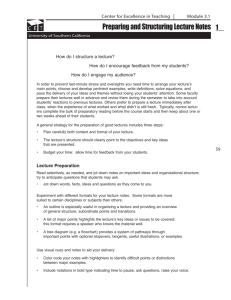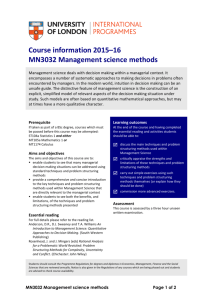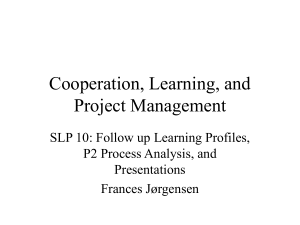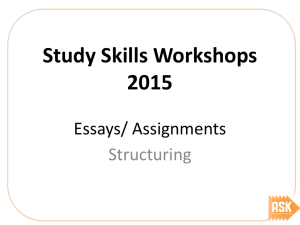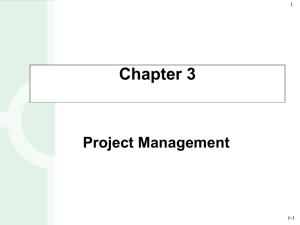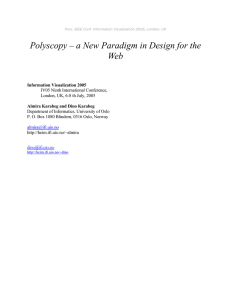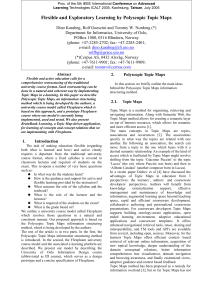Exploratory Learning
advertisement
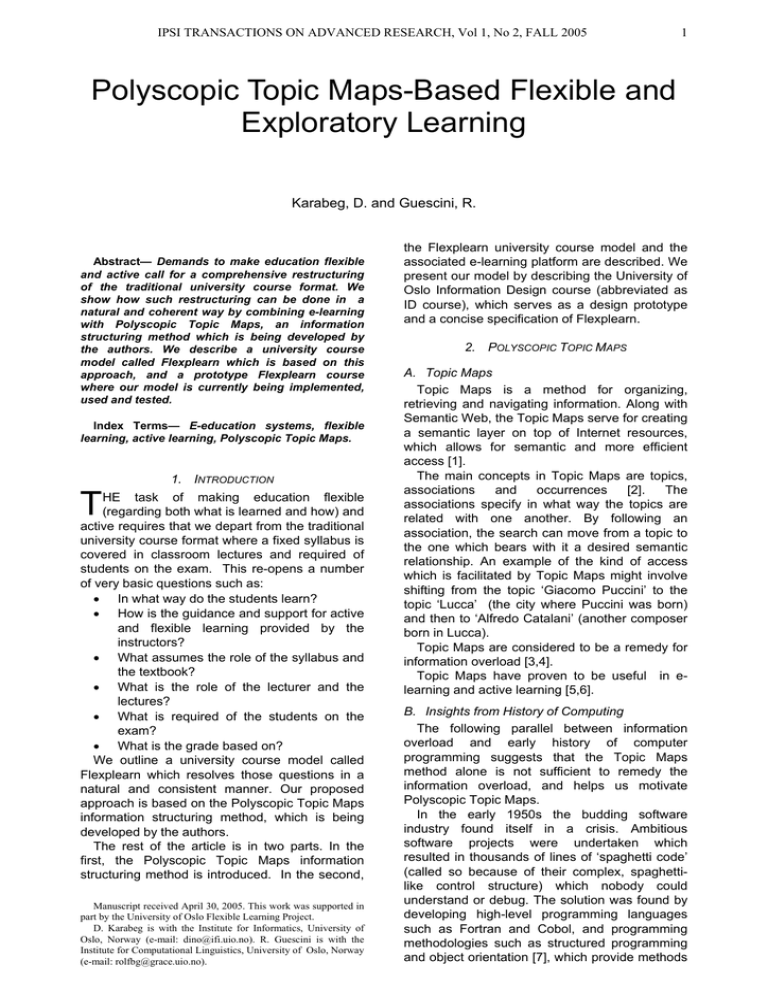
IPSI TRANSACTIONS ON ADVANCED RESEARCH, Vol 1, No 2, FALL 2005 1 Polyscopic Topic Maps-Based Flexible and Exploratory Learning Karabeg, D. and Guescini, R. Abstract— Demands to make education flexible and active call for a comprehensive restructuring of the traditional university course format. We show how such restructuring can be done in a natural and coherent way by combining e-learning with Polyscopic Topic Maps, an information structuring method which is being developed by the authors. We describe a university course model called Flexplearn which is based on this approach, and a prototype Flexplearn course where our model is currently being implemented, used and tested. Index Terms— E-education systems, flexible learning, active learning, Polyscopic Topic Maps. 1. INTRODUCTION T HE task of making education flexible (regarding both what is learned and how) and active requires that we depart from the traditional university course format where a fixed syllabus is covered in classroom lectures and required of students on the exam. This re-opens a number of very basic questions such as: • In what way do the students learn? • How is the guidance and support for active and flexible learning provided by the instructors? • What assumes the role of the syllabus and the textbook? • What is the role of the lecturer and the lectures? • What is required of the students on the exam? • What is the grade based on? We outline a university course model called Flexplearn which resolves those questions in a natural and consistent manner. Our proposed approach is based on the Polyscopic Topic Maps information structuring method, which is being developed by the authors. The rest of the article is in two parts. In the first, the Polyscopic Topic Maps information structuring method is introduced. In the second, Manuscript received April 30, 2005. This work was supported in part by the University of Oslo Flexible Learning Project. D. Karabeg is with the Institute for Informatics, University of Oslo, Norway (e-mail: dino@ifi.uio.no). R. Guescini is with the Institute for Computational Linguistics, University of Oslo, Norway (e-mail: rolfbg@grace.uio.no). the Flexplearn university course model and the associated e-learning platform are described. We present our model by describing the University of Oslo Information Design course (abbreviated as ID course), which serves as a design prototype and a concise specification of Flexplearn. 2. POLYSCOPIC TOPIC MAPS A. Topic Maps Topic Maps is a method for organizing, retrieving and navigating information. Along with Semantic Web, the Topic Maps serve for creating a semantic layer on top of Internet resources, which allows for semantic and more efficient access [1]. The main concepts in Topic Maps are topics, associations and occurrences [2]. The associations specify in what way the topics are related with one another. By following an association, the search can move from a topic to the one which bears with it a desired semantic relationship. An example of the kind of access which is facilitated by Topic Maps might involve shifting from the topic ‘Giacomo Puccini’ to the topic ‘Lucca’ (the city where Puccini was born) and then to ‘Alfredo Catalani’ (another composer born in Lucca). Topic Maps are considered to be a remedy for information overload [3,4]. Topic Maps have proven to be useful in elearning and active learning [5,6]. B. Insights from History of Computing The following parallel between information overload and early history of computer programming suggests that the Topic Maps method alone is not sufficient to remedy the information overload, and helps us motivate Polyscopic Topic Maps. In the early 1950s the budding software industry found itself in a crisis. Ambitious software projects were undertaken which resulted in thousands of lines of ‘spaghetti code’ (called so because of their complex, spaghettilike control structure) which nobody could understand or debug. The solution was found by developing high-level programming languages such as Fortran and Cobol, and programming methodologies such as structured programming and object orientation [7], which provide methods IPSI TRANSACTIONS ON ADVANCED RESEARCH, Vol 1, No 2, FALL 2005 for creating and structuring easily comprehensible programs. The conditions around information are now similar. The new information technologies have allowed us to produce enormously large quantities of information [9]. When we now structure information by using the techniques which were developed for much smaller quantities, chaos results [9,10]. Indeed, the initial version of the World Wide Web has provided hypertext as a tool for modular structuring and hyperlinks as an equivalent to program control. But we presently have no underlying metaphor or principle which would help us structure information. Furthermore, from the point of view of our parallel, the hyperlinks are quite similar to the GOTOs (they allow for arbitrary jumps from one context to another), and so are the Topic Maps associations. The consequence is that the Internet information is currently structured in a spaghetti-like manner, similar to early computer programs. What is needed is a collection of structuring principles and techniques, analogous to the ones introduced by early programming methodologies. Those are provided by the Polyscopic Modeling information design methodology. C. Polyscopic Structuring of Information Polyscopic Modeling is proposed as prototype information design methodology [11,12,13]. Polyscopic structuring of information is one of the key elements in this methodology. In keeping with the basic principle of programming, polyscopic information is structured in terms of small, manageable modules, each representing a simple coherent view, as explained below. The polyscopic structuring of information is based upon the notion of scope, which may be understood as a viewpoint or a way of looking. Multiple scopes are considered as possible and even necessary. The scopes, and the associated views, can be either high-level or low-level. The high-level views, like the high-level modules in a hierarchically structured program and the view from the top of a mountain, present the large picture. The low-level views present the details. As in a structured computer program, the highlevel modules provide the structure for organizing the low-level modules. At the same time, the high-level modules provide the context and the motivation for the information contained in the low-level modules. Obviously, the polyscopic structuring of information involves more than just reorganizing the existing information. The lacking high-level information needs to be created. The missing low-level information needs to be created and the existing one needs to be reconfigured. The Polyscopic Modeling methodology provides the principles, criteria and methods that are required for this task [12,13]. In addition to vertical abstraction whose goal is 2 to create the high-level information, the methodology also supports vertical abstraction. Polyscopic information is presented in terms of different aspects which intuitively correspond to ‘sides’ or ‘angles of looking’. The aspects may reflect different reader categories, ways of looking at the subject etc. The main principles of polyscopic information structuring may be formulated as follows: • Information exists on all levels. Both highlevel and low- level views must be provided (vertical abstraction). • Information has multiple aspects, some of which are subtle or hidden. The most relevant aspects must be provided (horizontal abstraction). • Information is a function of the way of looking or scope. The scope is coherent if it represents a single level of detail and angle of looking (or intuitively, if it reflects a single viewpoint on the metaphorical mountain). Each information module must be associated with a single coherent scope (coherence). • The awareness of the scope is crucial for proper understanding (intuitively, one must know where on the metaphorical mountain one is standing when looking at a piece of information). Each information module must be associated with a clear and correct representation of the scope (orientation). • The scope determines the view (intuitively, the scope is the control knob given to the reader to switch between views). The reader must given the capacity to select the view by changing the scope (navigation). To see the naturalness of the polyscopic structuring of information, it is useful to think of inspecting a hand-held object. Naturally, one uses the capability of the hand to turn the object at different angles and take it closer or further from the eye to explore the object. In a similar way, the polyscopic information structuring gives the reader the capability to select scopes, in order to facilitate the exploration of the presented subject. Polyscopic information structuring supports the ‘holistic’ or ‘multiple-perspective’ thinking. This way of thinking is especially relevant in the post-industrial era, where it has become increasingly important that both technical, sociocultural, political and other aspects of an issue be taken into account in decision making [14]. D. Making the Topic Maps Polyscopic The Topic Maps provide a natural platform for polyscopic structuring of information. The instance/type and the subclass/superclass constructs allow for vertical abstraction and for implementing the levels. The scoping constructs IPSI TRANSACTIONS ON ADVANCED RESEARCH, Vol 1, No 2, FALL 2005 allow for horizontal abstraction and for implementing the aspects. The Polyscopic Modeling methodology provides principles for structuring the Topic Maps in a polyscopic way. To use again our parallel, the Topic Maps are in the role of a low-level programming language. The goal of Polyscopic Topic Maps research is to create standard structuring constructs analogous to the DOWHILE and the IF-THEN-ELSE control statement. While a systematic account of this research would at this point be premature, for the purpose of our educational model a simple Polyscopic Topic Map prototype is sufficient. In this prototype, the hierarchy of levels is implemented by providing the taxonomy, which is a hierarchical organization of the main concepts involved (Figure 1). The aspects reflect the user interests and profiles, ways of looking at the material covered and the kinds of information that is being presented. 3. FLEXPLEARN COURSE MODEL We now describe the Flexplearn course model by describing the University of Oslo Information Design course (INF3210/4210, in further text ‘ID course’), which been developed as a prototype and a test case of Flexplearn. E. Subject of Study The subject of study of the ID course is information design, understood as conscious and purposeful use of information and information technology. The course includes a broad spectrum of related themes such as visual literacy and graphic profiling, software tools such as the Macromedia Dreamweaver and Adobe Photoshop, motivational issues such as relativism and information overload, philosophical, social and political issues around information creation and use etc. The methodological approach to information, represented by the Polyscopic Modeling methodology, serves both as the unifying theme and as the source of guidelines. It is not difficult to understand the need for this type of course. Academic communication cannot remain restricted to books, articles and other traditional presentation formats. Students need to learn how to use the new media technology. But even if one wants no more than to learn how to create Web pages, proficiency with Web design software will not be sufficient. To be able to communicate in a new way and to truly exploit the advantages of the new medium, one needs to look more deeply into the very nature of information, learn about various elements of visual communication such as colors and fonts, about information structuring and navigation etc. Furthermore, in the Age of Information, students need to learn about our changing information needs, subtle psychological and cultural effects of information and understand 3 how information is related to economic and political power. The methodological approach to information further leads to the creation of new methods for stating and proving research results [15]. Exposure to the methodological approach can help the researcher in a traditional field broaden the repertoire of themes and methods, and the researcher in a new inter-disciplinary field develop the required methodological framework. F. Students The student population of the ID course is highly diverse. At present the course has about 120 enrolled students representing a broad range of backgrounds and interests. The students are in part computer science majors (that being the department where the course is taught) and in part majors in a variety of departments around the University of Oslo campus. Some of the students are working full time. The course can be taken both on the undergraduate and the graduate level. We are also planning to extend the course internationally. This diversity of student situations, backgrounds and interests further motivates our flexible learning approach. G. A Flexible Learning Environment The notion of a flexible learning environment is central to the Flexplearn model. The purpose of a learning environment is to provide a variety of learning resources, and a rich and inspiring environment in which learning happens in a number of ways, not the least by actively exploring a certain theme or themes of interest. The flexibility is both with respect to the time and place of learning (a sufficient part of this environment is available online to make distance learning feasible), and with respect to what is learned (the students learn according to their own needs and interests). The ID course provides a flexible learning environment for studying information design. Students learn from one another, from the instructors and from the online and other resources. The main role of the course instructor is to set up and coordinate the flexible learning environment. Standard tools such as a Wiki and a discussion forum are provided. Other tools are being designed and experimented with. Whenever possible, the learning resources are made available online. A resource is made available by ‘placing it on the map’ (the ID course Polyscopic Topic Map). The course Polyscopic Topic Map is where all the online learning resources can be found. An example of a learning resource may be a guest lecture about Topic Maps which discusses the information overload as motivation. This lecture is videotaped and placed on the map as a topic. Suitable associations with ‘standards and markups’ in ‘tools’, and with ‘information overload’ in ‘issues’, are added to this topic. The IPSI TRANSACTIONS ON ADVANCED RESEARCH, Vol 1, No 2, FALL 2005 Topic Maps lecture can then be accessed both by scanning through the ‘lectures’ aspect of the map and by following the associations from any of the associated topics. In this way the student who may be interested in, say, the information overload, can easily access all the learning resources that are associated with that topic. H. The Course as a Design Project A salient characteristic of the ID course Flexplearn environment is that the students learn (in part) by co-designing this environment. In the ID course the students learn information design by designing the ID course and the course materials. The course instructor has the role of the head designer, facilitating and coordinating the individual projects. I. Student Projects The students organize themselves into one to four person groups with the task of doing term projects. By participating in projects, the students learn information design in two ways: by exploring a theme which is of interest for information design, and by presenting this theme by using information design methods and tools. The goal of each group project is to create a polyscopic presentation of the explored topic area. A student group might, for example, take a technical theme such as the Adobe Photoshop, about which a lot has already been written and published online. Even then the group will be able to do creative and useful work by: • Creating a brief high-level presentation of Photoshop. The main goal is to present Photoshop to the students in the course so efficiently that within minutes of reading one is able to understand what Photoshop is all about and what tasks it may be good for. • Organizing the best available resources (texts, tutorials, examples etc.) as low-level data. Here the goal is to select and organize the available learning resources and provide efficient and easy access to those resources. • Learning and using the state-of-the-art information design tools to accomplish the task. Often the students will use Flash, XML and other tools and techniques to create the high-level view and to structure information and implement the navigation. In this way the students are given an opportunity to learn the technical tools and to use them in the information design way. The ID course Polyscopic Topic Map serves as a platform for orchestrating the project work. The students are told that, when organizing their project groups, they are in a similar position as the globe explorers five centuries ago. The ID course Topic Map reflects the current status of our knowledge about information design (‘the 4 world as we know it’). The students’ task is to organize an ‘expedition’, venture into a part of the ‘map’ of their choice, explore it and bring back knowledge and resources. Based on everyone’s findings, we supplement, refine and re-create the map for the next generation of students. Naturally, the ID course Polyscopic Topic Map provides also the ‘containers’ for the knowledge and the resources resulting from the student ‘expeditions’. At the beginning of the term each student obtains a personal map, which is then used for keeping track of the ‘itinerary’ and for placing the resources (books and articles, online tutorials, insights etc.). The result of each student ‘expedition’ is a project website and its documentation. In addition, each student produces a personal report. J. Lectures Two kinds of lectures are provided: classroom lectures and group lectures. The classroom lectures are focused on the basics of information design, the material which constitutes the academic core of the subject. The group lectures are intended to provide support for project work. They give a systematic overview of information design tools and techniques. The classroom lectures are taught by the class instructor and guest lecturers. They cover such themes as ‘tackling the information overload’, ‘Information, Not Manipulation’ and ‘Creation of Meaning’. The guest lecturers represent a broad variety of backgrounds and vocations. The group lectures are taught by two teaching assistants. One of them (presently Fredrik Refsli) is a graduate student in the Norwegian School of Art and Design. The other teaching assistant (presently Rolf Guescini) is a graduate student in Computer Science and Linguistics. Fredrik covers systematically such themes as visual thinking and graphic profiling, and tools such as Photoshop, Illustrator and Framemaker. Rolf covers the more technical subjects such as XML and PHP. Some of the group meetings are reserved for hands-on help. The students bring their home computers or use the ones available in class, show their projects and ask questions. The teaching assistants walk around and give help and advice. K. Exams Presently, the course has a small take-home midterm and a combined take-home and oral final exam. We are planning to experiment with other evaluation forms, including more frequent online ones. The midterm task is to set up the project team and theme and describe the itinerary for the personal and team journey. Each student draws her personal itinerary on the ID course Topic Map and describes the milestones and the personal interests and goals. One of the effects IPSI TRANSACTIONS ON ADVANCED RESEARCH, Vol 1, No 2, FALL 2005 of this midterm is that the students become familiar with the Topic Maps and with the ID course Topic Map. The individual take-home final is limited to four pages of text. The student answers several fundamental questions about information design, and further questions reflecting her participation in the group project. Before the oral exam, the instructor and the teaching assistants examine the group projects and individual take-home exams, make comments and give tentative grades. The members of each group take the oral exam together. The exam consists of a tenminute project presentation, followed by questions addressed to individual students, which are based on each student’s personal itinerary through the ID course Topic Map. L. Grading The student’s personal itinerary through the ID course Topic Map allows us to tailor the grade to the student’s own learning path and depart from a fixed syllabus. The grade in the course reflects 50% what the student has taught others (by participating in the project and in other ways) and 50% what the student has learned from others. 4. CONCLUDING REMARKS What has been said about Polyscopic Topic Maps and about our Flexplearn course model allows us to discuss the advantages that Polyscopic Topic Maps offer when used as a basis for flexible and exploratory learning. To see the usefulness of Topic Maps in this context, it is sufficient to draw conclusions from our parallel: If the student should be allowed to depart from habitual learning paths and explore new terrains by following her own needs and interests, what could be more natural than to provide a good, reliable map as support for such journey? As we have seen, such a map can also allow the student to present the trajectory and the results of her explorations, and the instructor to conduct a customized exam. The question remains, why should the Topic Maps for flexible and exploratory learning be polyscopic? There are several ways to answers this question. One of them follows directly from our parallel: The geographical maps are polyscopic. They have levels (of detail or granularity), each serving a different purpose. They also have aspects: physical, political, climatological and others. For very similar reasons, the guidelines for flexible and exploratory learning also need to be presented polyscopically. The high-level view, like the coarse-scale map or the view from the top of the mountain, provides an overview and allows the student to choose the general direction. The lowlevel views provide more concrete guidelines in terms of learning resources. The aspects serve 5 a similar end as in the geographical maps, namely for distinguishing between various usages and different kinds of information presented. Another reason for using Polyscopic Topic Maps is that this allows us to take care of the prerequisites. While learning is no longer restricted to a fixed linear path, which would naturally allow for presenting the material in the required order, the order is now maintained by requiring that higher-level nodes in the Information Design taxonomy (Figure 1) are studied before the lower-level ones. It is natural to present the foundations and general insights as high-level views, and of the material for more in-depth study as low-level view. When the learning resources are placed in a hierarchical taxonomy, as it is the case in the ID course, then the students can easily orient themselves by first learning the parent nodes and then the low-level ones. This also supports learning at the right level of generality, which is efficient. Polyscopic Topic Maps support good thinking and learning habits. The levels allow us distinguish what is fundamental from what is ephemeral, the large picture from the detail. The aspects allow us to control the complexity by distinguishing between different angles of looking (technical, humanistic, philosophical etc.) while still keeping them together. The Polyscopic Topic Maps are particularly suitable for multi-disciplinary, inter-disciplinary and trans-disciplinary learning and research. They allow for overcoming the separation between the humanistic and the technical aspects of an issue, which needs to be encouraged [14]. During the brief history of e-learning, the systems which are relatively straight-forward online implementations of the conventional class model have been received in practice with varying degrees of success. Our Flexplearn course model is a result of a different approach where a completely new learning model is developed, which on the one hand exploits the advantages of the available technology, and on the other hand employs the known principles of good learning. The still limited practical experience with the Flexplearn suggests that this might indeed be an approach to e-learning which ‘works’. The approach taken in the development of Flexplearn can be generalized and applied to other tasks [16]. Our final remark is about the Flexplearn approach as a course development strategy. Initial experience suggests that Flexplearn may provide a productive and inspiring flexible learning environment also for a large number of enrolled students. Economies of scale can then warrant the use of additional resources, inviting international speakers, investment into state-ofthe-art communication design etc., which would IPSI TRANSACTIONS ON ADVANCED RESEARCH, Vol 1, No 2, FALL 2005 6 Figure 1: Information Design taxonomy. then further increase the chances of creating a productive and inspiring flexible learning environment. REFERENCES [1] [2] [3] [4] [5] [6] [7] [8] [9] [10] [11] [12] [13] [14] [15] [16] ISO 13250. http://www.isotopicmaps.org/rm4tm/ Pepper, S., “The TAO of Topic Maps,” http://www.ontopia.net/topicmaps/materials/tao.html Biezunski, M., “Understanding Topic Maps,” http://www.infoloom.com/whitepaper.htm Garshol, L. M., “What are Topic Maps?” http://www.xml.com/pub/a/2002/09/11/topicmaps.html). Dichev, C., Dicheva, D., Aroyo, L., “Using Topic Maps for web-based education,” Int. J. of Advanced Technology for Learning, Vol. 1, No 1, 2004, 1-7. Larvik, S., Nordeng, T., “BrainBank Learning - building personal topic maps as a strategy for learning,” XML Europe 2004. Amsterdam, April 2004. Dahl, O., Dijkstra, E., Hoare, C., “Structured Programming,” Academic Press, 1972. Lyman, P., et al., “How Much Information 2003,” http://www.sims.berkeley.edu/research/projects/howmuch-info-2003/ Wurman, R.S., “Information Anxiety 2,” QUE, 2001. Postman, N., “Informing Ourselves To Death,” Keynote speech at German Informatics Society conference, Stuttgart, October 11, 1990. Karabeg, D., “Designing Information Design,” Information Design Journal, vol. 11(1), Fall 2003. Karabeg, D., “Polyscopic Modeling Definition,” In Griffin, R. at al (Ed.), “The Turning of the Tide,” Selected Readings of the IVLA, 2004. Karabeg, D., “Information Design – An informing for the st 21 century,” keynote speech, proc. IPSI conference Stockholm, September 2004. Linstone, H. A., “Decision Making for Technology Executives,” Artech, 1999. Karabeg, D., “Addiction Pattern.” In Griffin, R. et al. (Ed.) “Exploring the Visual Future: Art Design, Science & Technology,” International Visual Literacy Association, 2001. Karabeg, D., “Design Is The Alternative to Tradition,” Proc. EAD6 conference, Bremen, March 2005. Dino Karabeg has a doctorate in computer science/algorithm theory from the University of California at San Diego. Since 1992 he is an Associate Professor at the Department of Informatics, University of Oslo, where he is developing a methodological approach to use and creation of information. Rolf Guescini is a graduate student in the Department of Computer Science and Linguistics at the University of Oslo with research interest in Topic Maps and e-learning.
